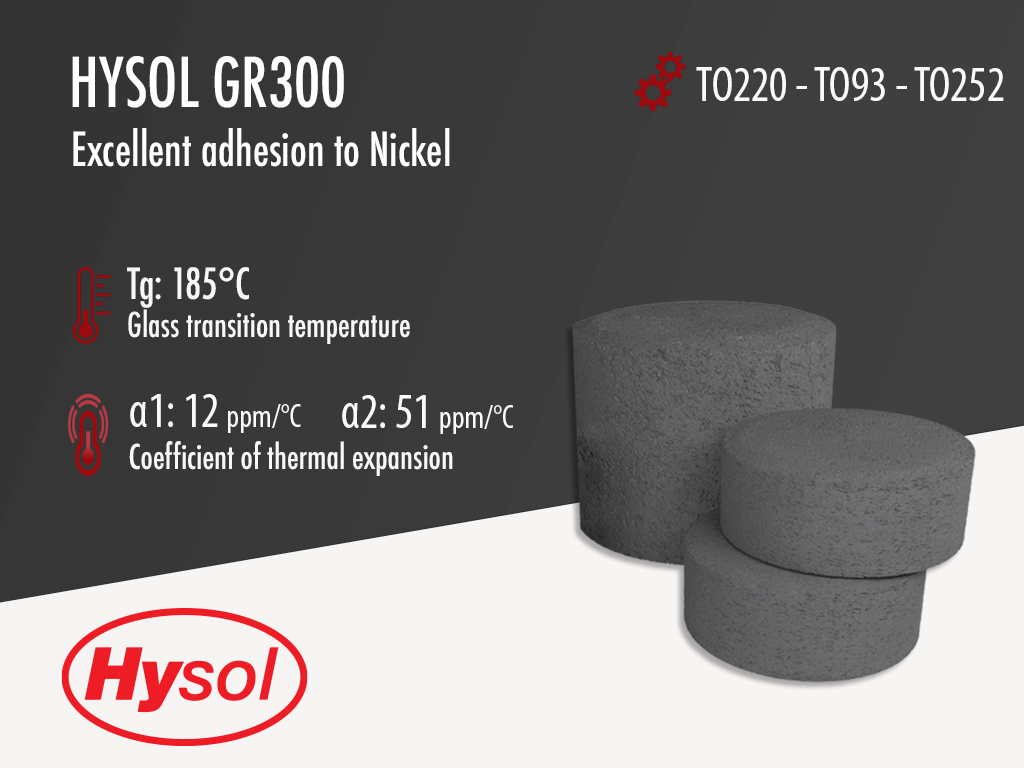Hysol GR300 | Black Epoxy Mold Compound
- Designed for TO220 & TO247 packages
- Excellent HTRB performance
- Excellent adhesion to Nickel (Ni) leadframes
Product Description
Hysol GR300 is a black semiconductor-grade epoxy molding compound designed for the encapsulation and protection of TO220 and TO247 power devices. Once molded and post-mold cured, this product provides optimum protection and reliability for these semiconductor devices. It exhibits good HTRB results and strikes an excellent balance of performance and moldability. While it is a great product, new developments have been made since its formulation so you might want also want to take a look at the new and improved Hysol GR30 that has better moldability and electrical properties.
Hysol GR300 is an environmentally "green" product, meaning that doesn't contain any bromine, antimony or phosphorus flame retardants. Previous MG-series EMC dominated the space for power semiconductors but used halogen-containing flame retardants. This next generation epoxy mold compound replaces these older generation products. This material is designed to achieve JEDEC Level 1 requirements at 260°C reflow temperature on Nickel or Nickel-plated leadframes. Hysol GR300 meets UL 94 V-0 Flammability at 1/8 inch (3.18mm) thickness.
Technical Specifications
| General Properties | |
| Color Color The color | Black |
| Filler Content | 80 % |
| Specific Gravity Specific Gravity Specific gravity (SG) is the ratio of the density of a substance to the density of a reference substance; equivalently, it is the ratio of the mass of a substance to the mass of a reference substance for the same given volume. For liquids, the reference substance is almost always water (1), while for gases, it is air (1.18) at room temperature. Specific gravity is unitless. | 1.94 |
| Electrical Properties | |
| Volume Resistivity Volume Resistivity Volume resistivity, also called volume resistance, bulk resistance or bulk resistivity is a thickness dependent measurement of the resistivity of a material perpendicular to the plane of the surface. | 2.7x1016 Ohms⋅cm |
| Thermal Properties | |
| Glass Transition Temperature (Tg) Glass Transition Temperature (Tg) The glass transition temperature for organic adhesives is a temperature region where the polymers change from glassy and brittle to soft and rubbery. Increasing the temperature further continues the softening process as the viscosity drops too. Temperatures between the glass transition temperature and below the decomposition point of the adhesive are the best region for bonding. The glass-transition temperature Tg of a material characterizes the range of temperatures over which this glass transition occurs. | 185 °C |
| Thermal Conductivity Thermal Conductivity Thermal conductivity describes the ability of a material to conduct heat. It is required by power packages in order to dissipate heat and maintain stable electrical performance. Thermal conductivity units are [W/(m K)] in the SI system and [Btu/(hr ft °F)] in the Imperial system. | 0.95 W/m.K |
| UL 94 Rating UL 94 Rating Flammability rating classification. It determines how fast a material burns or extinguishes once it is ignited. HB: slow burning on a horizontal specimen; burning rate less than 76 mm/min for thickness less than 3 mm or burning stops before 100 mm V-2: burning stops within 30 seconds on a vertical specimen; drips of flaming particles are allowed. V-1: burning stops within 30 seconds on a vertical specimen; drips of particles allowed as long as they are not inflamed. V-0: burning stops within 10 seconds on a vertical specimen; drips of particles allowed as long as they are not inflamed. 5VB: burning stops within 60 seconds on a vertical specimen; no drips allowed; plaque specimens may develop a hole. 5VA: burning stops within 60 seconds on a vertical specimen; no drips allowed; plaque specimens may not develop a hole | V0 |
| Chemical Properties | |
| Moisture absorption | 0.33 % |
| Curing Conditions | |
| Transfer Pressure | 40 - 100 kg/cm2 |
| Transfer Time | 5 - 30 s |
| Physical Properties | |
| Spiral Flow @ 175°C | 34 cm |
Additional Information
Designed for TO220 & TO247 devices
TO220 and TO247 are big, bulky packages, so molding these products with a standard mold compound is fairly easy without using any fine fillers. The trouble with these packages however is that epoxy mold compounds used typically fail Hig Temperature Reverse Bias (HTRB) testing, which exposes the device to humidity and temperature while the device is under BIAS. Devices often experience "gate leakage" under these conditions and fail catastrophically.
Furthermore, these devices are often used using a Nickel (Ni) leadframe, which is very difficult to adhere to. Therefore, epoxy moldng compound must have a very good adhesion to Nickel to achieve MSL1 preconditoning.



